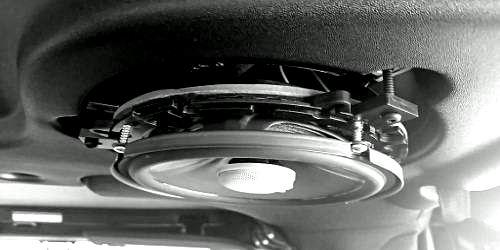While a speaker upgrade can improve the sound of your car stereo alone, you can also install a subwoofer to help fill out the low end, or power your speakers with an external amp to beef up their sound production. As with any stereo equipment, make sure to match the power handling (RMS) and impedance of your speakers to any other equipment they’ll be sharing connections with.
Below, we present our reviews of the 4 best 4×6 speakers on the market:
Infinity Kappa 4×6 Speakers
With one of the highest sensitivity ratings among 4×6” speaker options on the market (94 dB), these Infinity speakers are truly the cream of the car audio crop. The ¾” soft dome tweeters are edge driven, increasing the amount of power they can deliver and maintaining a smooth, clear sound down into the midrange. The glass fiber woofer uses the company’s patented Plus One+ technology to give you a bigger bass sound and expand the low-end frequency response. Whether they’re powered using an amp or just your stereo, these speakers will give you detailed and accurate sound reproduction across the dynamic and frequency spectrums.
Polk Audio AA2461 4×6 Speakers
The woofer cone in the Polk MM461p is made of a woven glass composite. The added stiffness of the material makes for a lighter-weight cone, giving it better detail and a faster response overall to improve the clarity of the bass. Combined with the oversized voice coils, you’ve got a speaker (see full specs) that can deliver great sound across the frequency range. They’re easy to mount and exceptionally durable, making them perfect for Jeeps and other off-roading vehicles. With a sensitivity of 90 dB and a power handling of 50 watts RMS, they’ll do fine if powered by a factory system but really shine when powered by an external amp. These are among the best 4×6 speakers for the money.
Kicker DSC46 4×6 Speakers
These coaxial speakers from Kicker’s DS line offer a thin profile, meaning they’ll fit in cars that have a shallow mounting depth, making them more versatile for a wider range of vehicles. Though the profile is thin, the sound certainly isn’t. The stiff polypropylene woofer cone gives you powerful low frequencies without sacrificing definition in the midrange, while the PEI dome tweeter produces bright and sparkling highs. These versatile pups can produce massive sound even when they’re run off of a factory receiver, with a sensitivity of 88 dB and an RMS of 120 watts. If you’re on a budget, these are likely the best 4×6 speakers you can buy.
Performance Teknique Neodymium 4×6 Speakers
If it’s value you’re looking for, these speakers from Performance Teknique deliver it with a great pair of speakers. The neodymium tweeter gives you great clarity in the upper frequencies, with crisp definition that extends down through the mid and low range. If you’re looking for booming bass from your speakers alone, this may not be the right model for you. If you use a subwoofer to power your low end anyway, however—or if you’re more concerned with sound quality than volume—these little pups deliver at an unbeatable price.
4×6 Speaker Sensitivity
The sensitivity rating is a measure of how efficiently a speaker can convert electrical power into volume, and is represented as a number of decibels (dB). The higher the sensitivity rating, the more volume a given speaker can produce. The speaker’s sensitivity rating is obtained by powering the speaker with a single watt of energy and then measuring its volume level at one meter distance. While the variation between sensitivity ratings with the speakers above might look slight, even a variation of a decibel or two can make a big difference. A speaker with a sensitivity of 91 dB can produce the same volume from 25 watts of power that a speaker with a rating of 85 dB would need 100 watts to generate.
All of the speakers on this list have a high enough sensitivity to produce a lot of volume if they’re given enough power. Where a speaker’s sensitivity rating really comes into play is if you’re looking to get a big sound without upgrading multiple components in your system. Running off of a factory stereo, a speaker with a sensitivity in the eighties will get decent but not window-shaking volume. The Infinity Kappa speakers (see full specs) listed above may cost a bit more than a speaker with a lower sensitivity, but could ultimately be an easier and more cost-effective upgrade because you won’t need to buy an amplifier to get the decibels you’re looking for.
4×6 Speaker Woofer Cone Materials
When it comes to home audio equipment, the size of the woofer has a lot to do with how well it reproduces low-end frequencies. In the car audio world, the size of the speakers is a bit more limited. The Plus One technology used by Infinity gets more surface area out of the woofer cone than most speakers of the size, but generally speaking the only way manufacturers have of boosting the output of the low end is to experiment with different materials in the cone’s composition.
Stiffer cones deliver both more accuracy in the low-frequency sound representation and more power in the overall output. Injected-molded polypropylene (also called IMPP) uses minerals like carbon or mica to increase the strength and stiffness of the cone. This is one of the more popular woofer materials because it can deliver good bass at a relatively low cost to the manufacturer, which translates to better value for the consumer.
When searching for the best 4×6 speakers, know that higher-end car speakers may use a glass fiber woofer. This gives you better flexibility and response in the upper-low and mid-range tones, as well as a better heat dispersion, which means it can handle more power without distorting. Woven glass or glass fiber woofers can give you a better bass sound than composite, but at a price. If money isn’t a concern, glass is the way to go, but you can find excellent composite woofers that will still give you powerful sound for a fraction of the cost.








